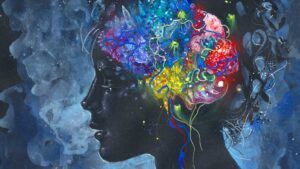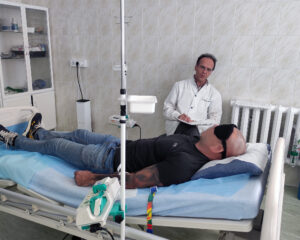
Over the past decades, psychopharmacology has failed to introduce revolutionary new drugs for psychiatry, and the U.S. Food and Drug Administration (FDA) approval of new drugs for the treatment of mental illness has dropped from 13 in 1996 to one in 2016.
Classical antidepressants currently on the market are ineffective, require weeks of chronic use to relieve symptoms, and many who suffer from depressive disorders do not achieve complete remission. Alternative drugs, such as tricyclic antidepressants, are associated with a greater risk of side effects, including weight gain, gastrointestinal disturbances and urinary retention, sexual dysfunction, and cardiovascular problems.
A new solution to these problems in medicine promises to be the second "psychedelic revolution", which has been actively developing over the past decade.
The term "psychedelic" (from the Greek psyche - mind or soul and delos - to show) is usually interpreted as "expanding consciousness." The use of psychedelic substances in indigenous ritual and healing practices goes back thousands of years. From the 1950s to the early 1970s, there was great scientific interest in these drugs. Clinicians began to explore the use of psychedelics to achieve a rapid therapeutic effect in alcohol and drug dependence, as well as in anxiety and depression associated with life-threatening diseases, and many other conditions. During this period, more than 1,000 studies were carried out documenting the treatment of more than 40,000 people with these drugs.
However, clinical research on psychedelics ceased in the early 1970s, and in the United States all of these compounds were included in Schedule I, which contains drugs with a high potential for abuse, no recognized medical use, and unsafe when used under medical supervision. The official version attributes this to the reaction of the authorities to the growing abuse of psychedelics in the mid and late 1960s, however, historians see the real reason in the fact that the condemnation of the "expanded consciousness" youth of the Vietnam War led to social upheaval, and then psychedelics were equated with drugs.
Since the beginning of the 21st century, there has been a renewed increase in research on the effects of psychedelic substances on humans. Significant advances have been made in understanding their effects on brain function, cognition and emotions. All of these factors have laid the foundation for government support for research on the possible clinical use of these drugs. In particular, the US Food and Drug Administration (FDA) in 2017-2018. granted psilocybin and 3,4-methylenedioxymethamphetamine (MDMA) breakthrough therapy status for the treatment of recalcitrant depression and post-traumatic stress disorder (PTSD), respectively.
Psychedelics are a class of hallucinogenic drugs that cause mind-altering and reality-bending effects when taken. Until recently, only negative manifestations were seen in these effects; today it is becoming more and more obvious that such altered states of consciousness carry significant therapeutic potential. Databases show that the number of peer-reviewed publications relating to psychedelics, including in humans, has more than doubled in the last decade. Research has become so active that psychedelic science is now one of the fastest growing disciplines in medical research. There are currently more than 400 clinical trials registered on the clinicaltrials.gov website investigating the effects of psychedelics.
A number of psychedelic substances are considered as the most promising methods of treatment, accompanied by the restructuring of pathological neural circuits. Given their extraordinary ability (unlike traditional antidepressants) to produce rapid and lasting changes in the structure and function of neurons even after a single dose, a new term was coined for these compounds - psychoplastogens.
Psychedelics offer new hope for effective treatment of mental disorders, as they are unlike any of the currently existing therapies. It is important to understand that psychedelics are not drugs. Unlike the latter (opioids, cocaine and methamphetamine), they are non-toxic, do not cause addiction and do not cause fundamental withdrawal symptoms. As renowned Canadian psychiatrist and best-selling author Gábor Maté said at a recent conference on psychedelic therapy, "Drugs are an escape from the mental pain generated by the mind, whereas psychedelics are the way to meet it and heal."
Classical psychedelic drugs are serotonin receptor agonists and exert their effects primarily by stimulating the 5-HT2A receptor subtype. These receptors mediate mood, emotions such as anxiety and aggression, sex, appetite, and other neuropsychiatric and biological processes such as anti-inflammatory processes, as 5-HT2A receptors are embedded in many cells of the immune system. 5-HT2A stimulation also promotes cognition, rapid and deep learning, and opens a window of opportunity for meaningful psychological transformation.
This group includes three main classes of chemicals. The first class are plant-derived indolamines, including N,N-dimethyltryptamine (DMT), 5-methoxy-DMT (5-MeO-DMT), psilocybin, and 4-hydroxy-DMT (psilocin, the active metabolite of psilocybin). The second class are phenylalkylamines, including mescaline (derived from the peyote cactus) and synthetic amphetamines. The third third group of substances are semi-synthetic ergolines such as LSD.
The second group is represented by MDMA (ecstasy) and acts by inhibiting the reuptake of serotonin and dopamine. The third group is formed by dissociative anesthetics, in particular ketamine, which are NMDA-type glutamate receptor antagonists. Psychedelic drugs that act by other mechanisms are considered atypical hallucinogens, such as ibogaine, which acts on multiple receptors, and salvinorin A, a kappa-opioid receptor agonist.
The altered states of consciousness induced by psychedelics can work as a powerful catalyst, loosening the boundaries of the ego and creating access to the "unconscious mind", thereby revealing the patient's deep mental and emotional problems. At the same time, the processing of mental traumas can occur both in a therapeutic and spontaneous way. Psychedelics can act by drastically lowering or shifting a person's defense mechanisms, as well as by changing old patterns of thought, comprehending emerging symbolic content, and creating new meanings. This effect can be very useful in therapy, as well as increase creativity and spirituality.
Classic psychedelics are characterized by special psychoactive effects, often referred to as mystical and characterized by feelings of oneness with the universe, reverence or sacredness, inexpressibility (the inability to express one's experience in words), transcendence of time and space, a noetic quality (a sense of revelation) and a deep positive mood. These experiences predict greater therapeutic outcome in conditions such as depression, existential distress, and intoxicant and drug dependence disorders.
People who have had a mystical experience caused by psychedelics report that it has become one of the most important events in their lives. As a rule, they subsequently have a process that humanistic psychology calls "unfolding" - a continuous disclosure of an understanding of themselves and their relationship with the world, which can occur over several weeks or months. Such experiences are positively correlated with a long-term increase in well-being and allow you to permanently change habitual patterns of behavior, ways of experiencing emotions and personality traits.
Although psychedelics are sometimes used as a stand-alone treatment, most clinicians and researchers combine these drugs with psychotherapy before, during, and/or after drug sessions, believing that subjective experience during acute drug effects and the successful integration of these experiences are critical to achieving a therapeutic effect.
It is now clear that the ability of psychedelic substances to accelerate psychotherapy is not due to a simple biochemical reaction, but depends on accompanying factors, in particular the conditions and environment. A psychedelic is not taken as a simple medicine, like analgin for headache relief. It is the unique experiences that occur during the period of action of the drug that determine whether the substance will be useful, harmful or neutral. The phenomenological and emotional effects of psychedelics are central to the therapeutic process.
Since psychedelics act as non-specific enhancers of psychological processes, the techniques used in psychotherapy can create a suitable state of mind for the psychological material associated with trauma or illness to manifest during a session.
The process of psychedelic psychotherapy usually consists of three stages: preparation, drug administration, and integration. At the beginning, participants undergo an initial diagnosis and selection, including discussing with a psychiatrist the issue of drug compatibility. In several preparatory meetings, the lead psychotherapist focuses on getting the patient comfortable with the potential range of experiences they may experience while under the influence of a psychedelic, exploring their expectations and intentions, and developing strategies for coping with any difficulties that may arise while taking the drug.
During the action of the substance, the main principle of the psychotherapist is a non-directive approach, focused on the present moment and using patience, empathy and accompaniment, rather than instructions or instructions. It is he who allows the patient to accept, rather than criticize, his psychedelic experience, and to participate in self-directed processes of searching for insights and creating meaning.
Integration involves sessions with a psychotherapist over the next 2 to 3 weeks, the purpose of which is to consolidate the insights gained during the psychedelic session and help the patient turn them into changes in daily life. It is not uncommon for patients to recognize the need to resolve past traumas or current psychological problems, and therefore seek further treatment in another form of specialized therapy.
All psychedelics are practically non-toxic and do not pose a significant risk. Given with due care, at therapeutic doses and clinical conditions, they do not cause dependence and fundamental withdrawal symptoms. Observational studies have failed to establish an association between lifetime use of psychedelics and negative long-term mental health outcomes.
Thus, psychedelics are now seen as promising therapeutic substances, representing a new model of treatment in psychiatry: they act quickly and have a lasting effect after the use of one or more doses. This is in stark contrast to the current treatment approach in traditional psychiatry, which usually consists of regular and long-term use of psychotropic drugs.
The introduction of psychedelic therapy in Ukraine is especially important. A full-scale war unleashed by the Russian Federation will have serious consequences for the mental health of many Ukrainians, especially combatants and people who were in the zones of occupation. Already, the number of cases of PTSD, anxiety and depressive disorders has increased. There is reason to believe that 20-60% of these people will suffer from these diseases in a complicated, difficult to treat form or not respond to existing therapy at all.
Therefore, the introduction of psychedelic therapy into medical practice will be timely. The first step on this path was the creation in 2022 of the Ukrainian Association for Psychedelic Research (upra.org.ua), whose task is to promote the legal therapeutic use and scientific research of psychedelics.
Ukraine today is faced with an exceptionally strong challenge to the existing mental health system of the nation, and it is obvious that the available solutions will be completely insufficient. Therefore, it is necessary now, without waiting for the “Vietnamese / Afghan” syndrome to flood us, to develop such a promising method of helping victims as psychedelic therapy is.
The Expio Center is the first and only medical facility in Ukraine that legally uses ketamine psychedelic psychotherapy since 2018. To date, we have conducted more than 500 successful sessions, which confirm foreign data on the effectiveness of this method, especially in resistant depression.

Ketamine psychotherapy session for a veteran with PTSD in our center
Based on the materials of the article "Renaissance of psychedelic therapy and its significance for Ukraine"
V. L. Matrenytskyi, candidate of medical sciences,
Medicine, 2022, (3–4), 37–59.
Original in Ukrainian: https://liksprava.com/index.php/journal/article/view/498
Report of V. L. Matrenytskyi at International scientific and practical conference "Psychedelic-assisted therapy in the treatment of post-traumatic conditions. International experience and prospects of implementation in Ukraine":
"Ketamine psychotherapy: a new era in the treatment of mental disorders".
